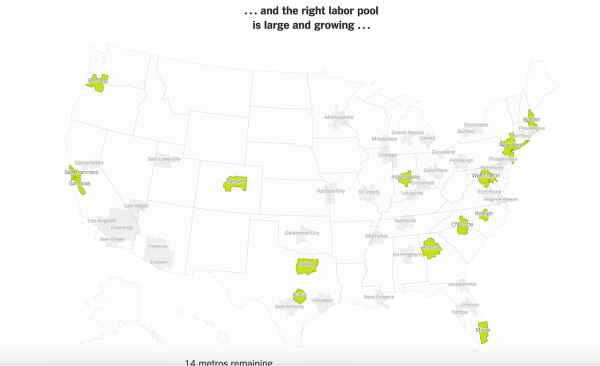Amazon’s vaunted process of finding a location for a second headquarters is like a time-lapse camera version of the shaping of the new geography of America. Just imagine: 8 million square feet of office space to accommodate today’s No. 4-ranked corporation’s growth plan, that in a decade or so would add up to 50,000 new jobs, many of them white collar positions with salaries that average in the six figures.
Not there today. There tomorrow. Changing everything. Imagine the land and entity acquisition pit fights that will go on among builders once the metro version of a beauty pageant comes down first to finalists and then a winner. Imagine being able to read the tea leaves so well as to already have secured a land and lot pipeline in the future HQ2 environs.
There is a new company town out there that may or may not recognize itself as that already.
Aaron M. Renn, a senior fellow at think tank Manhattan Institute and Urbanophile analyst, cites a Seattle Times infographic of the HQ2 casting call to lend visual perspective to the impact Amazon’s $5 billion spending plan on the initiative will have. Amazon’s office footprint occupies one of every five square feet of office space in Seattle, the nation’s 15th largest metro area, with 3.8 million people living there. All in, Renn points out that Amazon’s casting call is a moment of new geographical truth and validation for thoughts about America’s fly-over country’s near future. He writes:
“To me this is a big test of the thesis that the coasts are capped out, which will force growth into the interior. If Amazon picks a big, establish, high cost coastal center, that will tend to undercut it. We will see.”

Source: New York Times
Importantly, Amazon’s city search, as game-changing as it will be for the winner of the contest, is not only about Amazon. It’s a glimpse at how evolving economy corporate players interact with politics, society, transportation and accessibility, educational infrastructure, not to mention resilience and sustainability.
A Harvard Business Review take on the topic from Brookings Institution Metropolitan Policy Program fellows Amy Liu and Mark Muro encourages strategists to step back and look at the Amazon city bidding process as a bellwether for an iterative match-up between access to talent and new economy capital into the foreseeable future. Liu and Muro write:
Amazon’s wish list is an unusually public confirmation from one of the most recognized corporations in the world of the factors that make a local ecosystem relevant in today’s innovation economy. Among these factors are:
- Capacity to produce skilled, technical talent. The importance of talent pervades the Amazon RFP, with special mention of a “strong” university system, computer science programming in the K-12 education system, and opportunities for creative partnerships with community colleges and universities.
- Access to domestic and global markets through modern infrastructure. Amazon dwells extensively on the importance of proximity and connectivity to population centers. It seeks a strong infrastructure network of highways, international airports, and high-speed broadband to streamline logistics, conduct business, and access major employment pools.
- Connected and sustainable placemaking. The Amazon RFP reads like an urban planner’s dream, brimming with calls for energy efficient buildings, recycling services, public plazas, green space, and access to multiple modes of transportation. While Amazon will apparently consider greenfield sites as well as existing developments for its new headquarters, it emphasizes its interest in promoting walkability and connectivity between densely clustered buildings through “sidewalks, bike lanes, trams, metro, bus, light rail, train, and additional creative options.”
- Culture and diversity. Promoting an inclusive culture matters to Amazon. The RFP specifically calls for “the presence and support of a diverse population,” along with excellent higher education institutions and functioning local governance.
It’s implied here, but not stated explicitly, that the ultimate right answer will include a word many are tired of hearing but is not going away anytime in the near future: Millennials.
It’s also implied here, and not stated explicitly, that the ultimate right answer will include one of the economy’s tougher challenges right now, which is how to marry up attainable housing with high-voltage economic growth, and good planning with a welcome mat to young workers starting out in productive careers.
At the very least, the HQ2 cattle call unpacks how openly collaborative influential corporations will work in strategic decision-making, and offer a view at how housing’s more powerful players can make up some ground in working with localities on a path forward together.


